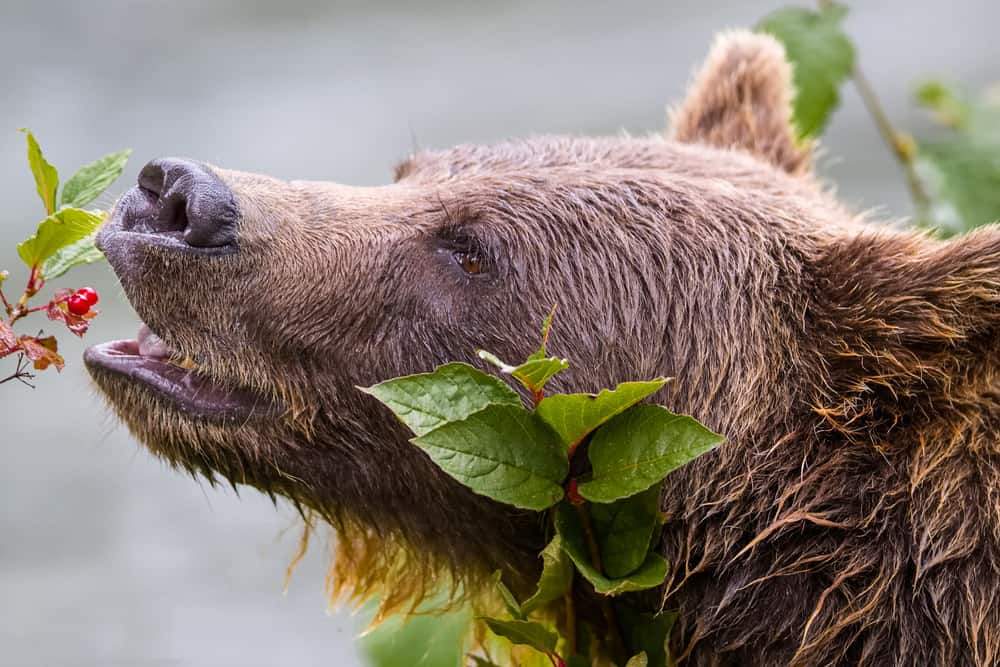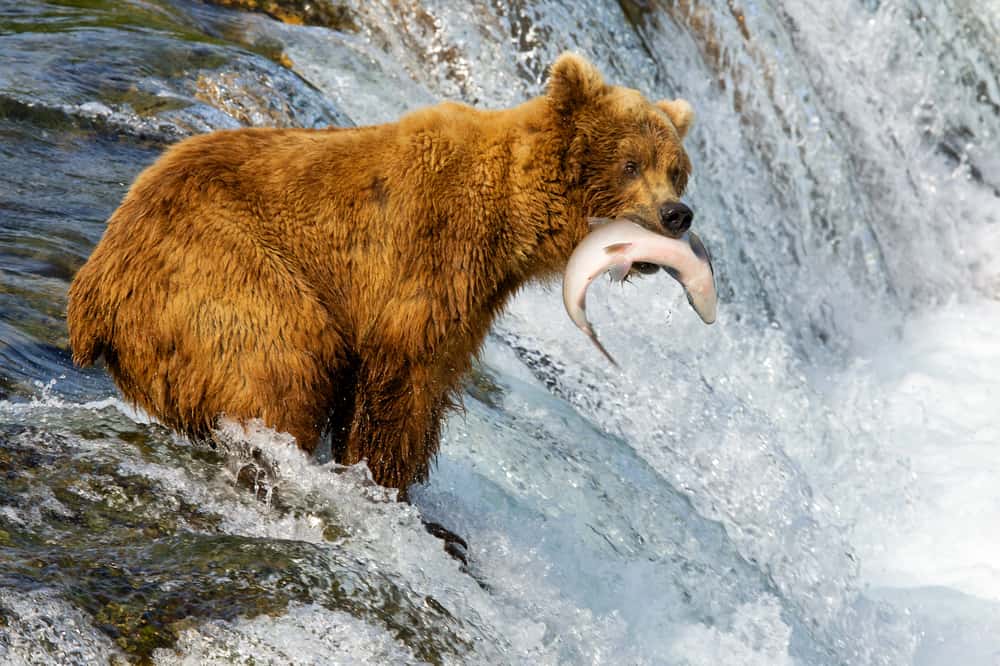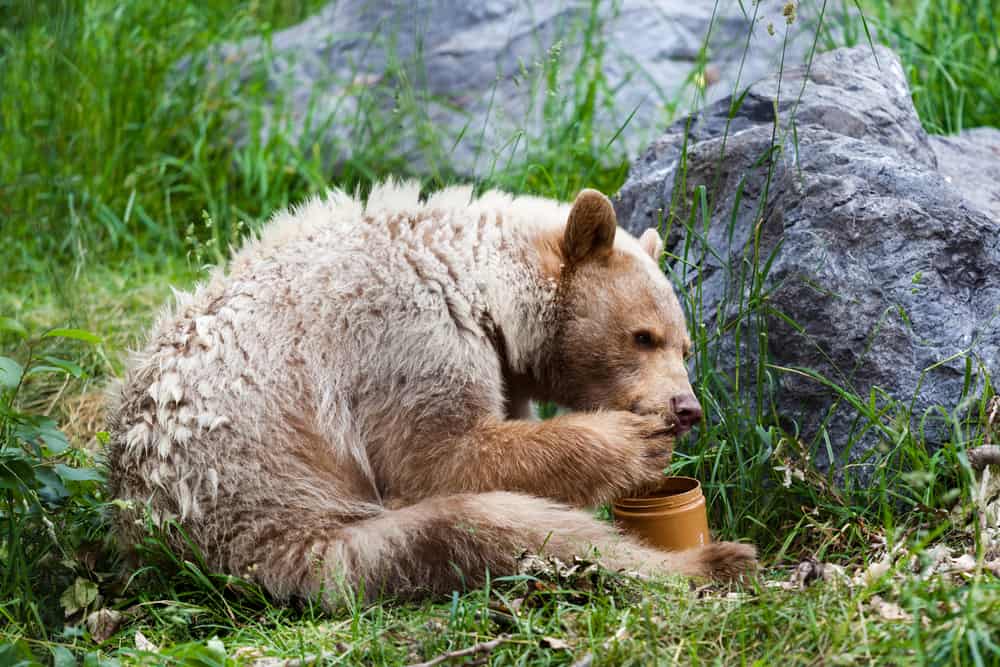How do bears build their houses? Bears are beasts like no other. Most people fear them because of their power and size. In their natural environment, they don’t seem so scary. All they do is eat all day, play around and rest.
So, what do bears eat? Let’s find out.
Bears Habits And Biology
There exist several species of bear, each uniquely adapted to their environments. Bears are carnivoran animals.
The animals eat flesh, though some feed on both plants and meat. A few eat only plants.
Polar bears primarily feed on meat, and giant pandas feed entirely on bamboo. Other bears are omnivores.
Brown bears possess powerful digging abilities and, therefore, mainly feed on roots. Spectacled bears have strong jaws that are capable of biting open fruits like pineapples.
Most, if not all bears, can climb trees to escape predators and reach food. The American black bears also climb trees to rest.
Sloth bears have long tongues and lack several front teeth that aids in feeding on termites and other burrowing insects.
A common characteristic possessed by all bears include standing and walking on their hind legs like human beings. They do this to identify a threat or determine the location of food.
The brown and the American bears are often active during the day and may also seek food during the night. Other bears are nocturnal and therefore are primarily active at night.
Adult brown bears are territorial and lead solitary lives. After mating, they leave the females to raise the cubs (offspring of bears) on their own.
Brown bears will only congregate in large groups when food is available in plenty in a particular location. The oldest and largest bears usually head the group and eat first.
Besides being excellent scavengers, bears also steal food stored by rodents and carcasses from other animals.
Bears’ diets vary with seasons. During autumn, bears enter a state known as hyperphagia, where they overeat to gain fat. They do this in order to make it through winter when they hibernate.
Bears may hibernate for up to six months without food or water. They also don’t urinate or pass feces throughout this dormant state. However, not all bear species hibernate.
Do Bears Eat Dirt?
Yes. Bears eat dirt. Before hibernation, bears eat moss and dirt to plug their system so they don’t have to go to the bathroom.
Mama bears still suckle their children during hibernation. They don’t have to leave their dens to drink water. The waste produced in their bodies is recycled.
After hibernation, bears also eat dirt. Grizzly bears feed on volcanic soil to jumpstart their digestive systems. The volcanic soils contain potassium and magnesium, which wipe out parasites that can cause diarrhea.
What Do Bears Like To Eat Most?
Several factors influence what bears eat in the wild. Some of these factors include the bear species, the area they inhabit, and changes in season. Generally, bears like to indulge themselves with foods like:
- Ungulates –are hoofed animals such as deer, moose, or elk. The offspring of ungulates are easy targets for bears.
- Fish –enjoyed most by bears is salmon. As good swimmers, bears can easily handle fishing on their own.
- Honey –provides bears with energy, and the critters also find it delicious.
- Carrion (decaying flesh of any animal) –provides bears with enough proteins, especially during winter.
- Berries
- Forbes
- Eggs
- Nuts
- Tropical fruits
- Reproducing insects
Bears eat according to what’s available during the different seasons. During spring, they eat flowers and leaves that are high in protein. They also tend to lean towards easily digestible foods such as:
- Dandelions
- Grasses
- Roots
- Sedges
- Skunk cabbage
- Cow parsnip
- Leaf buds
On occasion, they may hunt young moose and fawns for protein.
In summer, their diets incline towards the sweeter things:
- Berries –bears will eat anything from raspberries, chokecherries, blueberries, dogwoods, and wild sasparilla.
- Bumblebees –are high in protein, and bears consume them along with the hive and honey.
- Fish –Is the bears’ main source of protein during this season.
- Ants
- Wasps
In fall, bears feed like there’s no tomorrow. They do this to build fat reserves for the winter season as most enter hibernation. During this season, nuts are in plenty:
- Hickory nuts
- Acorns
- Pine nuts
- White-bark pine nuts
If lucky, bears might come across a wounded and animal or carrion that will serve as a rich source of protein.
Some species dig up a hole in a chosen area in winter, and others find a cave. Some bears, though, leave their dens from time to time to scavenge.
They find their way to human-inhabited areas where they will feed on livestock and fruit from trees. Bears dig up garbage to find anything they can eat to help get through the winter.
Foods To Avoid Feeding Bears
Bears, mainly omnivores, have many foods to choose from, especially plants and animals. They can feed on anything as simple as nuts and invade human beings’ garbage.
Due to scarcity of food, bears will eat almost anything and in large amounts if available when scavenging. Some of these substances may be harmful to their health. Examples include:
- Spicy or seasoned foods –are disliked by bears due to their hot flavor. However, some bears get used to the taste and may continue to eat it.
- Moldy foods –just like humans may cause stomach upsets or vomiting if ingested in large amounts. In fall or winter, they may eat a lot due to resources being scarce.
- A lot of sweets –when consumed in large amounts, bears tend to hibernate less. Studies also show that it decreases the rate of their cell growth. Hence, they age faster.
- Chocolate –contains theobromine. Bears can eat chocolate but in small amounts. If consumed in large quantities, it may cause heart attacks leading to death.
- The English yew –is a plant that has small berry-like structures called arils. The whole plant is poisonous. Bears have died due to the ingestion of the leaves and berries of this plant.
- Meat –carnivores and omnivores alike may consume flesh from prey animals or carrion. These animals sometimes carry parasites such as roundworms that cause a disease known as trichinosis.
Initially, bears experience mild symptoms such as diarrhea, nausea, and vomiting. More severe symptoms include pink eye, swelling of muscles, and weakness. Even so, the disease is not fatal.
During summer, salmon fish usually swim upstream to spawn (lay eggs) and then die. Grizzly bears congregate in large numbers to feed. A number of the salmon which swim upstream carry a bacterium.
The salmon that carry the bacterium when ingested cause salmon poisoning disease. Symptoms of the disease include vomiting, diarrhea, lack of apetite, weakness, and dehydration. If untreated, ultimately, it leads to bears’ death.
Tips To Feeding Bears
In some parts of the world, feeding bears is illegal. Bears naturally fear human beings and avoid contact as much as possible. But due to human interference, man and beast interactions are not uncommon.
But when you feed a bear, it loses the initial fear it once had. Bears possess good memories and a sense of smell. They will trace their way back to where they were offered the food in search of more.
Bears that get used to handouts lose their instinct to survive in the wild. They may end up dying of hunger or lack proper nutrition. Unless you are a zookeeper, try not to feed these creatures.
Bears kept in zoos require varied diets that mirror the range of plant and other food types they eat in the wild.
The caregivers should meet different species requirements, reflecting their diets and seasonal variation in the wild.
Caregivers should provide varying seasonal diets for bears that hibernate during winter
During spring, they are fed greens and veggies such as:
- Clovers or alfalfa
- Dandelions
- Wheat shoots
- Willow branches
- Fresh cut grass
- Root vegetables such as carrots
- Meat (with skin and bone if available)
During summer, caregivers provide the bears with plenty of fruits and bread, and other nutritional items mentioned in the list of foods offered during spring.
In autumn, the caregivers provide bears with root vegetables like carrots and parsnips. They supplement the diet with a surplus in fruit items, particularly berries.
Lastly, to ensure their diets are at par with bears in the wild, bears are primarily fed mast, nuts, and seeds. These foods are combined to provide a fatty meal.
By winter, the bears should be fat and decrease the amount of food they consume. During this stage, they are less active. The bears in captivity should be able to hibernate if the weather conditions and facilities in the zoo provide the essentials.
Frequently Asked Questions
What is a sub-adult bear?
Sub-adult bears are bears between the age of 2 to 5 years old. They live independently from their mothers but haven’t reached sexual maturity yet.
Summary
Bears should be in the wild, where they thrive most. These predators are more than capable of handling their own business. Please don’t give them handouts as you are not doing them any favors.
Now that we know what bears eat let’s make it our business to stay out of their business.


